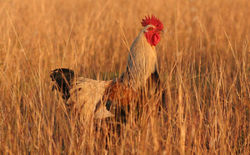
Rooster in grass, demonstrating the
"alert" stance before sounding an alarm
|
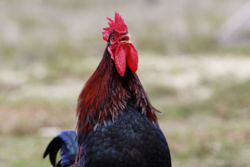
Rooster Crowing during daylight
|
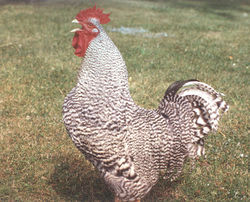
A "Barred Plymouth Rock" cock crowing
|
A rooster is a male
chicken, the female being a
hen. A young cock is called a rooster or a
cockerel. The term "rooster" is reputedly so used
because the cock is said to roost over clutches of
eggs to guard them. In fact, "roosting" is the action of
perching aloft to sleep at night, and is done by both
sexes. The cock is non-monogamous, and cannot guard several
nests of eggs at once. He guards the general area where his
hens are nesting, and will attack other roosters who enter
his territory. During the daytime, he often sits on a high
perch, usually 4-5 feet off the ground, to serve as a
lookout for his flock. He will sound a distinctive alarm
call if predators are nearby.
Name
"Cock" is the original name for the male and is still in
use in parts of the
English-speaking world, but has largely been dropped in
North America and Australia in favor of "rooster." According
to H. L. Mencken's The American Language, the euphemism
"rooster" took precedence over "cock" in the United States
during the Victorian era (and parts of the bird were
similarly renamed, such as the "drumstick" for "leg") to
avoid ostensibly sexually provocative language ("cock" is a
coarse slang term for the penis). However, the term "cocky",
an American slang adjective meaning "arrogant", and which is derived from
the "proud" strutting walk of the bird, is still considered
acceptable in polite conversation.
Male
Pheasants are often called Roosters as well.
Crowing
The cock is often pictured in art as crowing at the break
of dawn, and this is accurate. He can often be seen sitting
on fence posts or other objects, where he crows to proclaim
his territory. However, he will also crow during the rest of
the day, and even sometimes on a bright moonlit night. He
has several other calls as well, and can cluck the same as a
hen.
The sound made by the cock is spelt (onomatopoeia) as
"cock-a-doodle-doo" in English, but otherwise in some other
languages, such as: Arabic kookookoo-koo, Bulgarian кукуригу
(kukurigu) ,Catalan Co-co-ro-co, Chinese goh-geh-goh-goh,
Danish kykeliky, Dutch kukeleku, Esperanto kokeriko, Finnish
kukkokiekuu, French cocorico, German kikeriki, Greek
kikiriku, Hebrew ku-ku-ri-ku, Indonesian kukuruyuk, Italian
chicchirichi`, Japanese ko-ke kokkoh, Korean k'ok'iyo,
Lithuanian ka-ka-rie-ku, Latvian ki-ke-ri-gū, Norwegian
kykkeliky, Polish kukuryku, Portuguese Co'co'ro'co'co',
Romanian cucurigu, Russian ku-ka-rye-ku, Sanskrit काक,
Serbian ku-ku-ri-ku, Slovak kikiriki', Spanish qui-qui-ri-qui',
Swahili KokoRikoo koo, Swedish kuckeliku, Gujarati
kuk-de-kuk,Tamil ko-ka-ra-ko, Thai yeki-yeki-yek,Czech
kykyriki', Turkish üü-ürü-üüü and in Urdu kuk-roo-koon or kuk-roo-kroon.
Cultural references
The
Talmud refers to learning "courtesy from the rooster"
(eruvin 100b). This reference may be attributed to the
behaviour of a cock when he finds something good to eat: he
calls his flock to eat first. This call is distinctive from
regular clucking or crowing. While giving this call, he will
repeatedly pick up a morsel of food and drop it again to
attract the attention of the hens. A mother hen uses a
similar call and action to teach her chicks to feed.
At another place in the Talmud (תלמוד בבלי מסכת ביצה דף ז
עמוד א) it is said about the rooster: "[...] Everything that
fullfills its task at daytime, is born at daytime - this is
the rooster". ...
And again at another place in the Talmud (תלמוד בבלי מסכת
ברכות דף ז עמוד א) the rooster is seen as an indicator of
the short moment in the day where God could be angry and
would permit the cursing of a person by another: "[...] And
when is he [God] angry? - Abaye says: In [one moment of]
those first three hours of the day, when the comb of the
cock is white and it stands on one foot. Why, in each hour
it stands thus? - In each hour it has red streaks, but in
this moment it has no red streaks at all. (However, this
does not seem to apply to actual biology, because a cock's
comb does not change color in the morning. It might be a
literary
hyperbole intended to say that God does not permit
cursing others, since the moment described does not actually
exist. And indeed, this next story supports that view):
- In the neighbourhood of R. Joshua b. Levi there was
a Sadducee who used to annoy him very much with [his
interpretation of] texts. One day the Rabbi took a cock,
placed it between the legs of his bed and watched it. He
thought: When this moment arrives I shall curse him.
When the moment arrived he was dozing. [On waking up] he
said: We learn from this that it is not proper to act in
such a way. ..." (The translation here is taken from the
Soncino edition of the Babylonian Talmud)
Also the Greek philosopher Socrates has an interesting
connection to a rooster: After he has already drunken the
poison in his cell in Athens (at the end of the Platonic
Dialogue Phaidon) his last words are: "O Kriton, we still
owe a rooster to Asclepius".
Capons
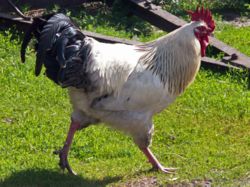
Rooster
A capon is a
castrated rooster. In this procedure the testes of the
cock are completely removed; a surgical procedure is
required for this as its sexual organs are not external
(most birds, the cock included, do not possess a penis). As
a result of this procedure certain male physical
characteristics will develop, but stunted:
- The comb and wattles cease growing after castration,
so the head of a capon looks small.
- The hackle, tail and saddle
feathers grow unusually long.
Caponization also affects the disposition of the bird.
Removal of the bird's testes eliminates the male sex
hormones, lessening the male sex instincts changing
their behaviour: the birds become more docile and less
active and tend not to fight.
This procedure produces a unique type of poultry meat
which is favoured by a specialised market. The meat of
normal uncastrated cocks has a tendency to become coarse,
stringy and tough as the birds age. This process does not
exist in the capon. As caponized cocks grow slower than
entire males they accumulate more body fat; the
concentration of fat in both the light and dark areas of the
capon meat is greater than in that of the uncastrated males;
overall, it is often thought that capon meat is more tender,
juicier and more flavorful than regular chicken.
Cocks as domestic pets
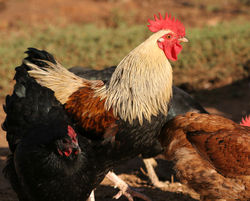
Cock amongst a flock of hens
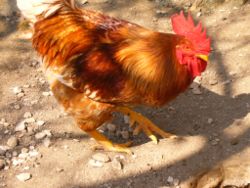
Cock when searching food
While it is not as common in cities as in small towns or
farms, some people do keep domestic cocks. It's debatable
whether or not this kind of environment is adequate for
these birds. However, cocks are common in Hawaii. Some general tips for raising and keeping the
well being of domestic cocks include:
- Giving them a wide and open area to live and walk
about, allowing them plenty of space to "roost"
- At night, keep them in a simple but comfortable
structure or bed, allowing them space to crow at dawn.
- Try to keep their sleeping space dark. Cocks usually
crow at the first sight of light, which could be
annoying to neighbours.
- Feed them cracked corn, sold at any live
poultry house.
- Clean their living space frequently.
- Prevent interaction between cocks whenever possible.
Symbol of France
The cock is a
national symbol of France and is used as an (unofficial)
national mascot, in particular for sports teams (such as
football (soccer) and
rugby union). Its origin appears to be from the play on
words between the Latin name for the bird (Gallus gallus)
and Gaul (Gallia), the Roman name for most of what is now
France. A rooster was chosen to be the mascot of the 1998 FIFA World Cup.
Cockfight
A cockfight is a contest held in a ring called a cockpit
between two
gamecocks. Gamecocks are not typical farm chickens. The
roosters are specially bred and trained for increased
stamina and strength. The comb and wattle is cut off of a
young gamecock because if left intact, it would be a
disadvantage during a match. Sometimes they are given drugs
to increase their stamina or thicken their blood, which
increases their chances of winning. They possess an inherent
aggression toward all males of the same species, and do not have to be trained to fight. It is a
natural instinct and they will fight to the death with no
training. Some people refer to conditioning as
"training" and this has caused much confusion.
Conditioning is giving an especially healthy diet and
strengthening exercises to the gamecock before a contest.
Cockfighting is considered a traditional
sporting event by some, and an example of
animal cruelty by others. Usually wagers are made on the
outcome of the match, with the surviving or
last-bird-standing being declared the winner.
Sources
P. Smith, The Chicken Book (North Point Press,
1982), passim.




